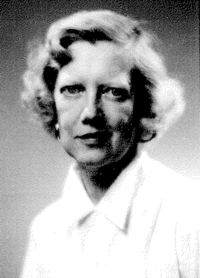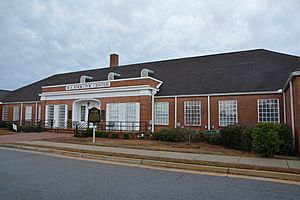Ellamae Ellis League facts for kids
Quick facts for kids
Ellamae Ellis League
|
|
|---|---|
 |
|
| Born |
Ellamae Ellis
July 9, 1899 |
| Died | March 4, 1991 (aged 91) Macon, Georgia
|
| Occupation | Architect |
| Years active | 1922–1975 |
| Children | 2 |
| Relatives |
|
| Signature | |
 |
|
Ellamae Ellis League (July 9, 1899 – March 4, 1991) was an important American architect. She was the fourth woman to become a registered architect in Georgia. People called her "one of Georgia and the South's most prominent female architects."
Ellamae worked as an architect for over 50 years. For 41 of those years, she ran her own company. She came from a family of architects. She was the first woman in Georgia to be chosen as a Fellow of the American Institute of Architects (FAIA). This is a very high honor for architects. She was only the eighth woman in the whole country to receive this award. Many buildings she designed, including her own house, are now listed on the National Register of Historic Places. In 2016, after she passed away, she was named a Georgia Woman of Achievement.
Contents
Ellamae's Early Life and Family
Ellamae Ellis was born in Macon, Georgia, on July 9, 1899. She was the fourth child of Susan Dilworth Choate and Joseph Oliver Ellis. She went to public schools and finished Lanier High School in 1916.
She attended Wesleyan College in 1917 and 1918. However, she did not finish college. She married George Forest League on June 27, 1917, which changed her plans.
Becoming an Architect
Ellamae had two children, Jean and Joe, born in 1919 and 1921. In 1922, her husband left her. She was divorced with two young children and no way to earn money.
Her family had many architects, going back six generations. Her uncle, Charles Edward Choate, was a well-known architect in Atlanta. Other relatives were artists, like Nell Choate Jones. Ellamae said her uncle gave her the idea to become an architect.
Starting an Architecture Career
In 1922, the Georgia School of Technology did not allow women to study architecture. This rule did not change until 1952. Ellamae later said it was very hard to get an architect's license in Georgia without a degree from Georgia Tech.
So, Ellamae found a different way to learn. She got a job as an apprentice at an architecture firm in Macon called Dunwody and Oliphant. She worked there from 1922 to 1929. While working, she took classes by mail from the Beaux-Arts Institute of Design (BAID) from 1924 to 1926.
Studying in France
Ellamae wanted to learn even more. She left her children with her parents and went to France. She studied for a year at the Ecole des Beaux-Arts at Fontainebleau in 1927 and 1928. Her cousin, Nell Choate Shute, went with her. In her architecture class, only three of the thirty students were women.
When she came back, she worked with other architects in Macon. She joined William F. Oliphant's new firm. But Oliphant died suddenly in 1933. Ellamae and her co-worker, Delmar A. Warren, faced a problem. Neither of them had a license. This meant they could finish old projects but could not legally take on new ones.
To get a license in Georgia, you needed an architecture degree or ten years of experience in a licensed office. Ellamae had the experience. She also had to pass a week-long exam. Her uncle helped her study for the engineering parts of the test. She passed that part but failed the design part, even though design was her strength. She felt the test was "designed to keep you out." She quickly took the design part again and passed.
Ellamae's Own Architecture Firm
In October 1933, Ellamae League opened her own architecture firm. At that time, only two percent of architects in America were women. In Georgia, even fewer women were architects. Ellamae was only the fourth woman to be a registered architect in the state.
Most women architects back then focused on designing homes. But Ellamae took on many different kinds of projects. From 1934 to 1969, she designed homes, offices, stores, churches, schools, hospitals, and even a service station.
I am always an architect. Not a woman architect, but an architect. I encourage women going into the profession not to concentrate on being separate as a woman but to concentrate on being a good architect.
—Ellamae Ellis League, Macon Telegraph interview, 1962
Her firm started during the Great Depression. One way she got projects was by working for the Public Works Administration. She designed many schools and hospitals. These became her favorite projects because they were complex and served the public.
Another important client was James H. Porter, who ran the Bibb Manufacturing Company. He hired Ellamae for many projects in Macon. This led to more work in other towns where his company had factories, like Porterdale and Bibb City.
Ellamae did not stick to one specific style. She believed in designing buildings that met the owner's needs and were pleasant to look at. She designed buildings in styles like Colonial Revival, Classical Revival, and Contemporary.
Growing Her Business
After World War II, her firm grew. Ellamae hired many young architects and helped them start their careers. Her own daughter, Jean (later Jean League Newton), also became an architect. Jean graduated from the Harvard School of Design in 1944 and joined her mother's practice. The firm later changed its name to League, Warren & Riley.
During her career, Ellamae worked on projects in five different states and 42 counties in Georgia. A large collection of her architectural drawings is kept at the Washington Memorial Library in Macon.
Community Involvement and Honors
Ellamae became a member of the American Institute of Architects (AIA) in 1944. She was only the second woman from Georgia to join. For many years, she was the only woman in the Atlanta chapter of AIA. She held several leadership roles at the state level. In 1957, she started the Macon chapter of AIA and was its first president.
In 1968, Ellamae League became the first woman in Georgia to be named a Fellow of the American Institute of Architects (FAIA). This was a huge honor. She was one of only eight women architects in the entire country to receive this award at that time.
She was also involved in many community groups in Macon. When the Grand Opera House was in danger of being torn down in 1967, Ellamae helped save it. She then oversaw the restoration of the building in 1969 and 1970.
Later Life and Legacy
Ellamae retired from her practice in 1975 due to illness. She continued to receive awards for her work. She passed away on March 4, 1991, and is buried in Riverside Cemetery in Macon.
The tradition of architects in her family continued. Her daughter Jean and her grandson Joseph Choate League Jr. also became architects.
Buildings Designed by Ellamae
Ellamae League designed, helped with, or restored many buildings. Several of these are now listed on the National Register of Historic Places (NRHP).
- Jones County High School (1936) in Gray, Georgia. This was one of her projects for the Public Works Administration. It is now a civic center.
- Herman and Allene Shaver House (1936) in Wayside, Georgia.
- Ellamae Ellis League House (1940) in Macon, Georgia. This was her own home until she passed away.
- Joseph and Mary Jane League House (1950) in Macon, Georgia. She designed this with her daughter Jean.
- Renovation and restoration of the Grand Opera House (Macon, Georgia) (1968–1970).
Other Notable Works
Here are some other important buildings Ellamae League designed:
- Porter Memorial Gymnasium (1938) in Porterdale, Georgia. This building was damaged by fire but was later turned into an outdoor event center.
- Leonard House (1939) in Sandersville, Georgia. This is a brick house in the Colonial Revival style.
- Comer Auditorium (1941) in Bibb City, Georgia. This building was restored in 2013 and is now called the Comer Center.
- Alexander School No. IV (1948 addition) in Macon, Georgia.
- Ballard-Hudson High School (1949) in Macon, Georgia. This school was later torn down.
- Twenty-two homes built between 1937 and 1959 in the Shirley Hills Historic District in Macon.
- Mr. & Mrs. J. C. Haynes Residence (1956) in Tucson, Arizona.
- Scottish Rite Temple (1962) in Macon, Georgia.
- "Grand Topper" House (1970) in Macon, Georgia. This house was built to help raise money for the Grand Opera House restoration. It was later owned by musician Gregg Allman.
Awards and Recognition
Ellamae League received many awards for her great work:
- In 1969, she received the Alumnae Award for Distinguished Achievement from Wesleyan College.
- In 1975, she won the Ivan Allen Senior Trophy for her work on the Macon opera house renovation.
- When she retired, she was given the AIA Bronze Medal for her "outstanding service."
- In 1982, she received the Bernard R. Rothschild FAIA Award, which is the highest honor from AIA Georgia.
- In 2016, she was inducted into the Georgia Women of Achievement Hall of Fame.
See also
 In Spanish: Ellamae Ellis League para niños
In Spanish: Ellamae Ellis League para niños




